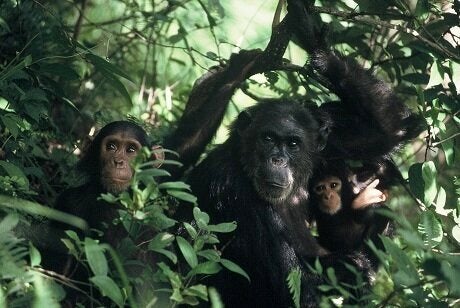Great apes - gorillas, chimpanzees, bonobos and orangutans - are our closest living relatives. These highly intelligent animals play a vital role in the forests in which they live; as dispersers of seeds, they are, in effect, forest architects. With the exception of orangutans who are more solitary, they live in tight and complex social groups, ranging from a small units of related gorilla families, to 'parties' of 100 or more individuals, in the case of chimpanzees and bonobos.
All great ape species are classified as Endangered or Critically Endangered by the International Union for Conservation of Nature (IUCN), which means they face a 'high risk of extinction' in the wild. The major threats to their survival include illegal hunting, the destruction of their forest habitat, and diseases such as Ebola. Political instability, insurgency and climate change also threaten their survival.
All great apes are listed on Appendix I of the Convention on International Trade in Endangered Species (CITES), which means that international commercial trade in the animals, their body parts or products derived from them is illegal.

Fifi ©E J Greengrass. More than a hundred live chimps are thought to have been captured from the wild in Africa for export to Chinese zoos in recent years
These facts make the significant and ongoing trade in live apes to Chinese zoos all the more perplexing.
According to the CITES trade database, on which official international transactions involving CITES-listed species are recorded, more than 180 live great apes were imported into China in the decade up to and including 2013:
•104 live chimpanzees from Guinea;
•12 live chimpanzees from Sierra Leone
•6 live chimpanzees from Chad;
•10 live gorillas from Guinea and;
•8 live orangutans from Indonesia (in 2010).
Live apes were also transferred to China from countries well outside the species' home ranges, including Sri Lanka, Denmark, Syria, Japan, Argentina, and the Philippines.
In most cases, these animals were classified as 'captive bred' by the exporting countries, and in almost all cases the Chinese authorities declared that they were destined for zoos, which, under CITES rules, does not count as 'commercial use' and are therefore subject to less stringent trade restrictions.
However, there are serious doubts as to whether these animals were indeed captive bred. The exporting countries that are, or are adjacent to, range countries for the species concerned, including Guinea, Sierra Leone, Chad and Indonesia, all lack recognised breeding facilities for these species. The more likely scenario is that they were captured from the wild, which would not only have been illegal, but would also have entailed the serious disruption, if not killing, of other animals in their social groups, impacting many more animals than those actually traded.
This not only has grave implications for the welfare of the affected animals and the conservation of the species in the wild, but also undermines the objectives of CITES and in some cases the countries own legislation.
The current whereabouts of most of these animals is uncertain. However, we do know that many animals who end up in Chinese zoos are trained in cruel ways for use in circus-style shows designed to attract the fee-paying public. Such shows serve no valid educational or conservation purpose, and to any right-thinking person the importation of live animals for this kind of use represents a clear commercial purpose. Unfortunately, current CITES rules provide this loophole for animals belonging to Appendix I listed species, and by doing so incentivise the illegal capture of animals from the wild with all the associated disruption and suffering, so they can be sold into the trade.
Sadly, the data available on great ape trade on the official CITES Trade Database almost certainly represents the tip of a large iceberg. In 2013 the United Nations Great Ape Survival Partnership (GRASP) reported that trade may directly or indirectly account for as many as 3,000 great apes each year, and subsequent media reports suggest that GRASP believes the illegal trade in great apes continues to flourish - not only for live apes but also ape body-parts for bushmeat, curios and traditional medicine.
The Born Free Foundation and our partners are doing all we can to persuade the authorities in the countries concerned, and at CITES, to investigate these issues and wherever possible close down the trade. We are also working to improve international and national legislation and its enforcement, to make sure that any loopholes in the systems designed to protect great apes and other endangered species from damaging commercial exploitation are closed.
Just as importantly, Born Free is working on the ground to support great apes in a number of ways. We support the Last Great Ape Organisation (LAGA) and other members of the Eco Activists for Governance and Law Enforcement (EAGLE) network in securing an improved law enforcement response to illegal trade of apes and other threatened species in multiple African countries. In Cameroon, apes who are victims of trade sometimes find their way to the Limbe Wildlife Sanctuary which cares for chimpanzees, gorillas and other primates, and which Born Free also proudly supports. We also provide funding for eastern lowland gorilla protection in Kahuzi Biega National Park, a UNESCO World Heritage Site in the Democratic Republic of Congo; and the Ngamba Island chimpanzee sanctuary, located on Lake Victoria in Uganda, and home to 47 chimpanzees all of whom were rescued from, or orphaned by, the bushmeat and pet trades.
Our remaining closest cousins are having enough difficulty coping with the damaging impacts people are having on their habitats. They can't afford any more losses through the greedy actions of a few people who only see their value in terms of what a foreign zoo or private individual will pay for them. These actions rob the animals of their homes, their communities of family members, the forests of vital players in the wider ecology, and their home countries of the potential to earn sustainable income from responsible wildlife tourism. We must continue to do everything we can to secure the future for these amazing animals in their forest homes, not behind bars in barren cages.
This article first appeared on the Born Free Foundation website.
